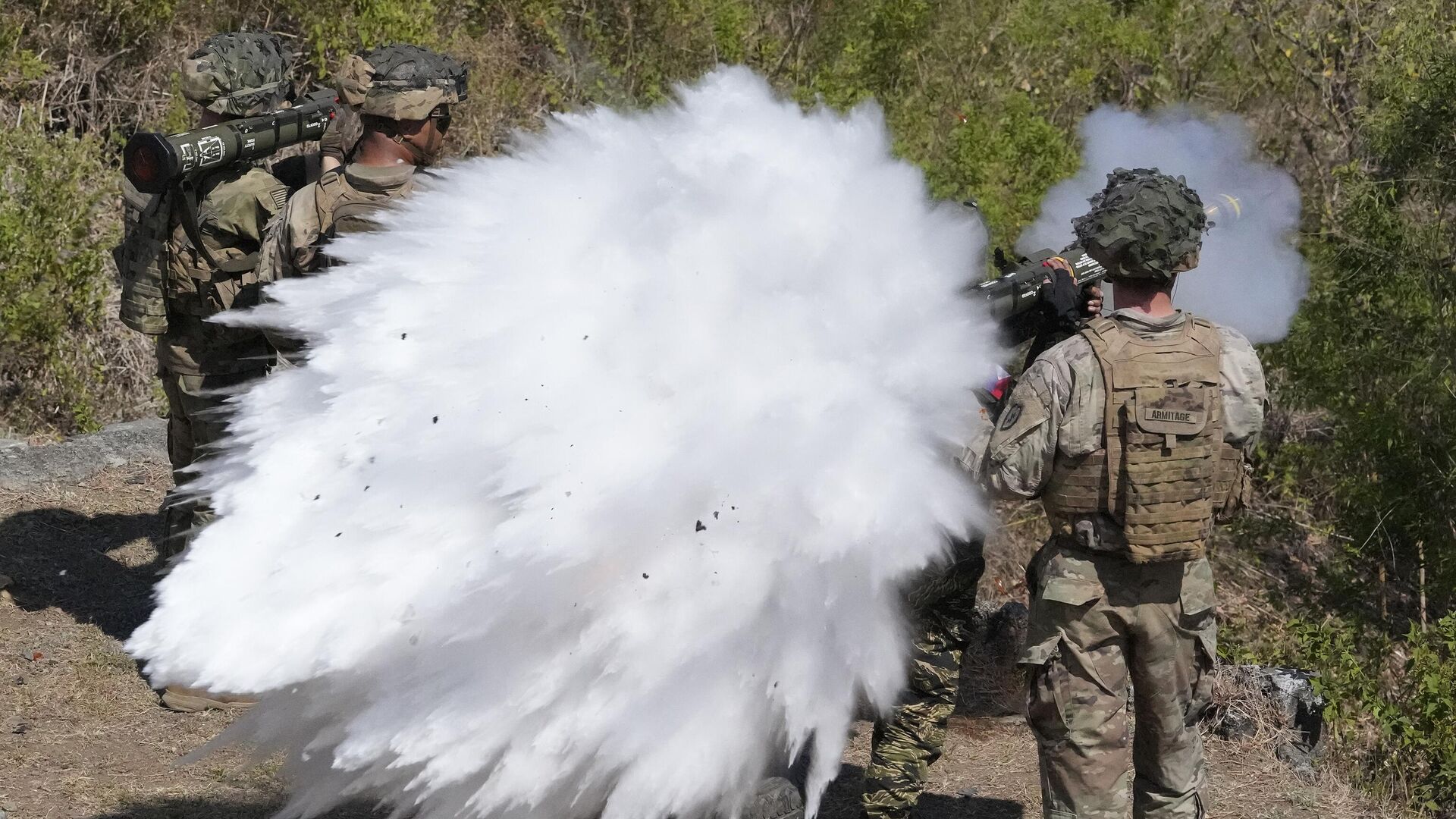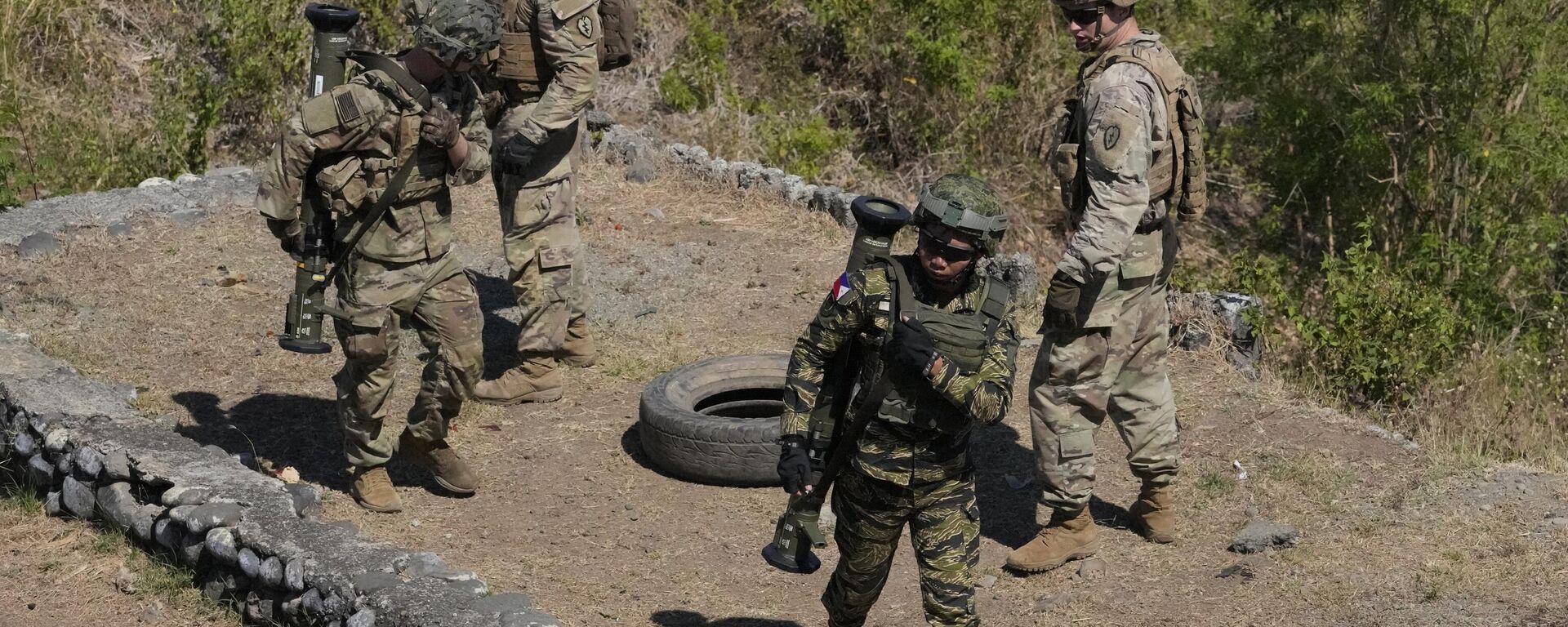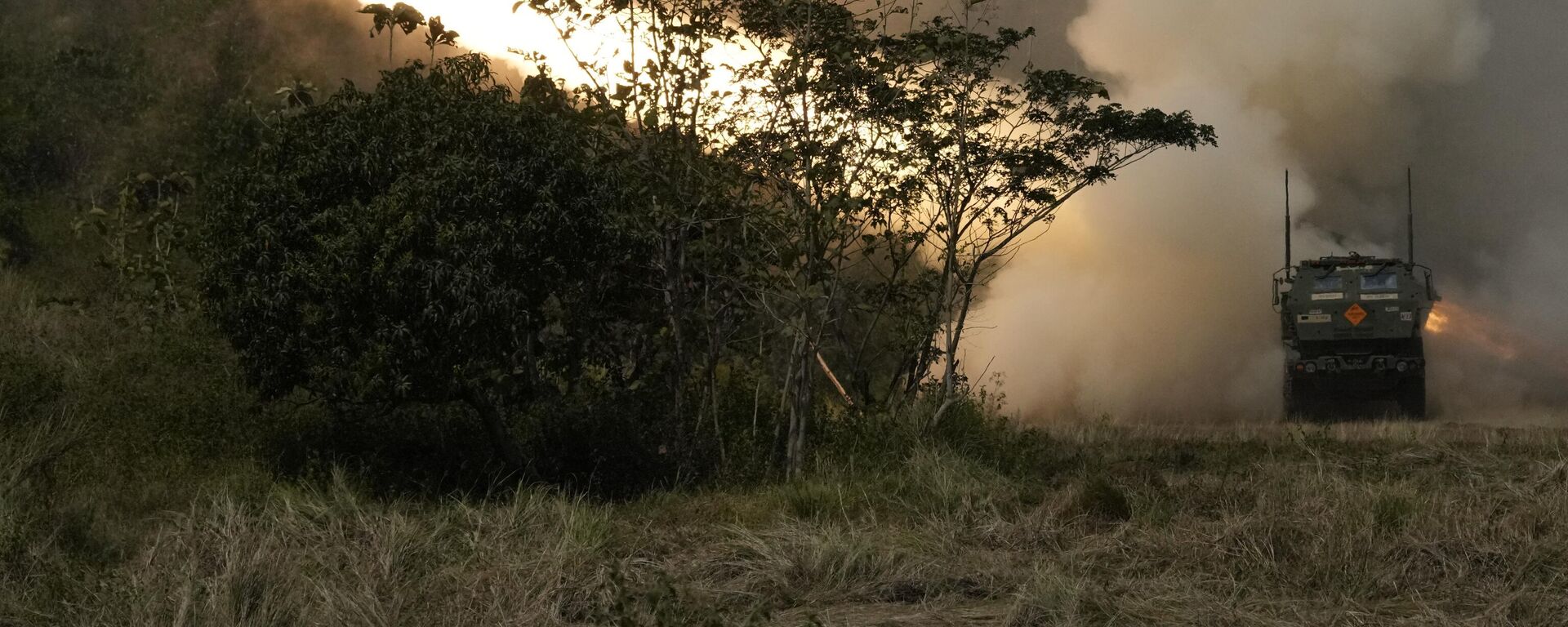https://sputnikglobe.com/20230501/new-us-bases-in-philippines-may-set-asia-pacific-on-fire-1109989761.html
New US Bases in Philippines May Set Asia Pacific on Fire
New US Bases in Philippines May Set Asia Pacific on Fire
Sputnik International
On May 1, Philippine President Ferdinand Marcos Jr. is due to meet his US counterpart Joe Biden. The upcoming official visit to Washington will be the first one by a Philippine president in more than 10 years.
2023-05-01T07:00+0000
2023-05-01T07:00+0000
2023-06-19T12:46+0000
us
ferdinand marcos jr.
joe biden
philippines
manila
china
asean
democrats
south china sea
military drills
https://cdn1.img.sputnikglobe.com/img/07e7/04/04/1109106943_0:0:3072:1728_1920x0_80_0_0_1d254890e53d9e650f3725c837419cfb.jpg
"A few days ago, the bilateral joint military exercise between the United States and the Philippines reached an unprecedented scale," Ge Hongliang, a researcher at the ASEAN Research Center of Guangxi University for Nationalities, told Sputnik. "At the same time, the Philippines opened four new military bases to the United States, including at the ministerial-level dialogue of the '2+2' talks between the United States and the Philippines, which ended not long ago. All these reflect that the two sides are moving in the direction of deepening alliance relations."The US doubled down on strengthening ties with the Philippines under Ferdinand Marcos Jr., who took the reins of the Southeast Asian nation last year. Unlike his predecessor, Rodrigo Duterte, who advocated Manila's independent foreign strategy, Marcos Jr. rushed to mend fences with the US, meeting first with his American counterpart Joe Biden in New York in September 2022 on the sidelines of the UN General Assembly.US-Philippines RelationsIt appears that Marcos Jr.'s pro-US stance goes deep into his family's history. In February 1986, Washington helped his father, former president Ferdinand Marcos, to flee an uprising in Manila and settle in Hawaii after two decades of rule. Then President Ronald Reagan offered him sanctuary.Remarkably, in June 1986, when then-Secretary of State George P. Shultz arrived in Manila, he was "greeted" by Philippine demonstrators who waved red flags, demanded the dismantling of two US military bases there, and carried placards condemning "US Imperialism" and saying "Shultz Go Home." Manila has been under Washington's close watch since the latter seized control over the former Spanish colony from Madrid after the 1898 Spanish-American War.The academic suggested that while the Philippine economy is unlikely to be the focus of the Biden administration, "Marcos Jr. obviously has some ideas about obtaining more economic resources from the United States under the Indo-Pacific economic framework." The Philippines is exceptionally important for Washington's Asia-Pacific agenda, as the US is trying to increase its influence in the region, according to the scholar.Is Manila on War Path?Over the last three weeks, more than 12,000 American, 5,000 Philippine and 111 Australian soldiers have taken part in the largest “Balikatan” joint military exercises to date in waters across the South China Sea and the Taiwan Strait. Needless to say, the event has not gone unnoticed by Beijing. The Chinese Embassy in Manila issued a statement that said that such drills "should not target any third party and should be conducive to regional peace and stability."In addition, earlier this month, Philippine and US defense and foreign secretaries discussed the development of nine Philippine military camps, where American troops would be staying indefinitely. As a result of the agreement, the US military would be able to establish strongholds and surveillance outposts in the northern Philippines and western Philippine provinces allowing Washington to extend its control to the South China Sea and the Taiwan Strait.He expressed doubts, however, that the US increased military presence in the region would change the established status quo in the South China Sea. While the US may threaten to destroy China's new military installations on the sea's reefs, it would not be hard for the People's Liberation Army to neutralize US additional bases in the Philippines should hostility break out, according to Dr. Teo.Unlike his predecessor, Duterte, who maintained good working relations with Beijing, Marcos, Jr. does not seem concerned that his actions would spoil relations with the People's Republic: as per the scholar, "the [present] Philippines government certainly thinks it is important to demonstrate their tough stance towards China" and uphold territorial claims in the disputed waters of the South China Sea, in particular.The scholar believes that "the most immediate and important impact" of these military bases and the Philippine government's actions is political and aims to show that Manila under Marcos Jr. is firmly on the US side. At the same time, however, "it also provides a sense of encirclement to Beijing," as per Dr. Teo.Dr. Zhang Baohui, director of the Centre for Asian Pacific Studies at Lingnan University in Hong Kong, pursues the thought, telling Sputnik that "the Philippines is obviously a target of Sino-US diplomatic competition [...] Some [leaders] believe cultivating mutual trust and cooperation with countries that they have disputes with is the right way. Duterte reflected this approach. Other leaders, however, believe fostering security cooperation with other countries is the best way to deter countries that they have dispute with. Marcos clearly believes in this approach, and this is why he is strengthening security ties with the US."Beijing is concerned by the US bellicose Asia-Pacific strategy which threatens to undermine stability in the region - and so is Russia. Earlier this week, Russian Defense Minister Sergey Shoigu accused Washington of attempting to undermine Shanghai Cooperation Organization countries’ security by trying to reestablish a military presence in Asia.
https://sputnikglobe.com/20230412/us-philippines-agree-to-modernize-bilateral-alliance-1109396481.html
https://sputnikglobe.com/20230426/joint-us-philippines-military-exercises-suspended-over-unknown-airspace-intruder---reports-1109854867.html
https://sputnikglobe.com/20230419/manila-refuses-to-allow-storage-of-us-weapons-meant-for-taiwan-defense-at-philippine-bases-1109672054.html
https://sputnikglobe.com/20230428/sco-vs-washingtons-asia-pacific-pacts-how-eurasian-bloc-can-oppose-us-diktat-1109923355.html
philippines
manila
china
south china sea
taiwan
Sputnik International
feedback@sputniknews.com
+74956456601
MIA „Rossiya Segodnya“
2023
News
en_EN
Sputnik International
feedback@sputniknews.com
+74956456601
MIA „Rossiya Segodnya“
Sputnik International
feedback@sputniknews.com
+74956456601
MIA „Rossiya Segodnya“
us-philippine relations, rodrigo duterte, ferdinand marcos jr., us-philippine military drills, taiwan strait, south china sea, philippines china relations, us military bases philippines, marcos meeting with joe biden, asia pacific, indo-pacific, shanghai cooperation organization
us-philippine relations, rodrigo duterte, ferdinand marcos jr., us-philippine military drills, taiwan strait, south china sea, philippines china relations, us military bases philippines, marcos meeting with joe biden, asia pacific, indo-pacific, shanghai cooperation organization
New US Bases in Philippines May Set Asia Pacific on Fire
07:00 GMT 01.05.2023 (Updated: 12:46 GMT 19.06.2023) Philippine President Ferdinand Marcos Jr. is due to meet his US counterpart Joe Biden on May 1. The upcoming official visit to Washington will be the first by a Philippine president in more than ten years. Marcos Jr. has already pledged to forge "an even stronger relationship" with the US.
"A few days ago, the bilateral joint military exercise between the United States and the Philippines reached an unprecedented scale," Ge Hongliang, a researcher at the ASEAN Research Center of Guangxi University for Nationalities, told Sputnik.
"At the same time, the Philippines opened four new military bases to the United States, including at the ministerial-level dialogue of the '2+2' talks between the United States and the Philippines, which ended not long ago. All these reflect that the two sides are moving in the direction of deepening alliance relations."
The US doubled down on strengthening ties with the Philippines under Ferdinand Marcos Jr., who took the reins of the Southeast Asian nation last year. Unlike his predecessor, Rodrigo Duterte, who advocated Manila's independent foreign strategy, Marcos Jr. rushed to mend fences with the US, meeting first with his American counterpart Joe Biden in New York in September 2022 on the sidelines of the UN General Assembly.
It appears that Marcos Jr.'s pro-US stance goes deep into his family's history. In February 1986, Washington helped his father, former president Ferdinand Marcos, to flee an uprising in Manila and settle in Hawaii after two decades of rule. Then President Ronald Reagan offered him sanctuary.
However, the US press reported at the time that Washington had a hand in the Yellow Revolution also known as the People Power Revolution and pressured Marcos to step down. The State Department was quick to embrace the new Philippine government of Corazon Aquino.
Remarkably, in June 1986, when then-Secretary of State George P. Shultz arrived in Manila, he was "greeted" by Philippine demonstrators who waved red flags, demanded the dismantling of two US military bases there, and carried placards condemning
"US Imperialism" and saying
"Shultz Go Home." Manila has been under Washington's close watch since the latter seized control over the former Spanish colony from Madrid after
the 1898 Spanish-American War.
"Although Marcos Jr. has publicly stated many times that the Philippines will pay attention to an independent foreign policy, in fact, his views on the regional and international situation are more complicated," said Ge Hongliang. "In the current regional and international situation, including the security challenges brought by the Russian-Ukrainian conflict and the impact of the Sino-US game, how to ensure the national security and regional security of the Philippines under the Indo-Pacific framework and coordinate US-Philippines relations under this framework is also important to Marcos Jr."
The academic suggested that while the Philippine economy is unlikely to be the focus of the Biden administration, "Marcos Jr. obviously has some ideas about obtaining more economic resources from the United States under the Indo-Pacific economic framework." The Philippines is exceptionally important for Washington's Asia-Pacific agenda, as the US is trying to increase its influence in the region, according to the scholar.
"This is (…) an attempt to try and stem China’s growing economic influence in the Philippines by competing to outdo China in ASEAN," Dr. Victor Teo, a political scientist who specializes in the international relations of the Indo-Pacific, told Sputnik. "Due to the question of geography and historical development, China and the Philippines have the natural conditions for closer economic cooperation in many fields in recent years. The key is, however, in the details. For the United States to be able to reverse what is happening, they would need to initiate an investment that far exceeds China’s to be able to have some sort of balance. The question is therefore if Washington is able to. The prospects do not look very good."
Over the last three weeks, more than 12,000 American, 5,000 Philippine and 111 Australian soldiers have taken part in
the largest “Balikatan” joint military exercises to date in waters across the South China Sea and the Taiwan Strait.
Needless to say, the event has not gone unnoticed by Beijing. The Chinese Embassy in Manila issued a statement that said that such drills "should not target any third party and should be conducive to regional peace and stability."
In addition, earlier this month, Philippine and US defense and foreign secretaries discussed the development of nine Philippine military camps, where American troops would be staying indefinitely.
The US already had access to five sites, namely Palawan, Pampanga, Nueva Ecija, the Visayas, and Mindanao. Under Marcos, Jr. they will have access to an extra four. Defense Secretary Lloyd Austin announced that the US was allocating more than $100 million to build infrastructure at these sites.
As a result of the agreement, the US military would be able to establish strongholds and surveillance outposts in the northern Philippines and western Philippine provinces allowing Washington to extend its control to the South China Sea and the Taiwan Strait.
"The US is clearly worried about China’s growing power in both East Asia and Southeast Asia," said Dr. Teo. "The additional bases are clearly first a political and military statement about US' continued interest and presence in the region, as well as an announcement from the Philippines government that conveys Manila’s security concerns. There are various theories and speculations raised in the media about Marco’s flip-flopping stance but what is clear, however, is that the Philippines would likely be vacillating between China and the US going forward as both Washington and Beijing continue to vie for influence in Manila. The bases would no doubt provide an additional logistical boost to US forces operating in the region particularly in the event of a Taiwan contingency or a clash in South China Seas."
He expressed doubts, however, that the US increased military presence in the region would change the established status quo in the South China Sea. While the US may threaten to destroy China's new military installations on the sea's reefs, it would not be hard for the People's Liberation Army to neutralize US additional bases in the Philippines should hostility break out, according to Dr. Teo.
Unlike his predecessor, Duterte, who maintained good working relations with Beijing, Marcos, Jr. does not seem concerned that his actions would spoil relations with the People's Republic: as per the scholar, "the [present] Philippines government certainly thinks it is important to demonstrate their tough stance towards China" and uphold territorial claims in the disputed waters of the South China Sea, in particular.
The scholar believes that "the most immediate and important impact" of these military bases and the Philippine government's actions is political and aims to show that Manila under Marcos Jr. is firmly on the US side. At the same time, however, "it also provides a sense of encirclement to Beijing," as per Dr. Teo.
Dr. Zhang Baohui, director of the Centre for Asian Pacific Studies at Lingnan University in Hong Kong, pursues the thought, telling Sputnik that "the Philippines is obviously a target of Sino-US diplomatic competition [...] Some [leaders] believe cultivating mutual trust and cooperation with countries that they have disputes with is the right way. Duterte reflected this approach. Other leaders, however, believe fostering security cooperation with other countries is the best way to deter countries that they have dispute with. Marcos clearly believes in this approach, and this is why he is strengthening security ties with the US."
Beijing is concerned by the US bellicose Asia-Pacific strategy which threatens to undermine stability in the region - and so is Russia. Earlier this week, Russian Defense Minister
Sergey Shoigu accused Washington of attempting to undermine
Shanghai Cooperation Organization countries’ security by trying to reestablish a military presence in Asia.
"The West’s opposition to strengthening multipolarity is most active in the Asia-Pacific region, where the US has initiated the breakdown of the existing ASEAN-based system of regional cooperation,” Shoigu said at a SCO defense ministers meeting in New Delhi on Friday. "The US’ true goal is to inflict a strategic defeat on Russia, threaten China and maintain its monopoly position in the world."






